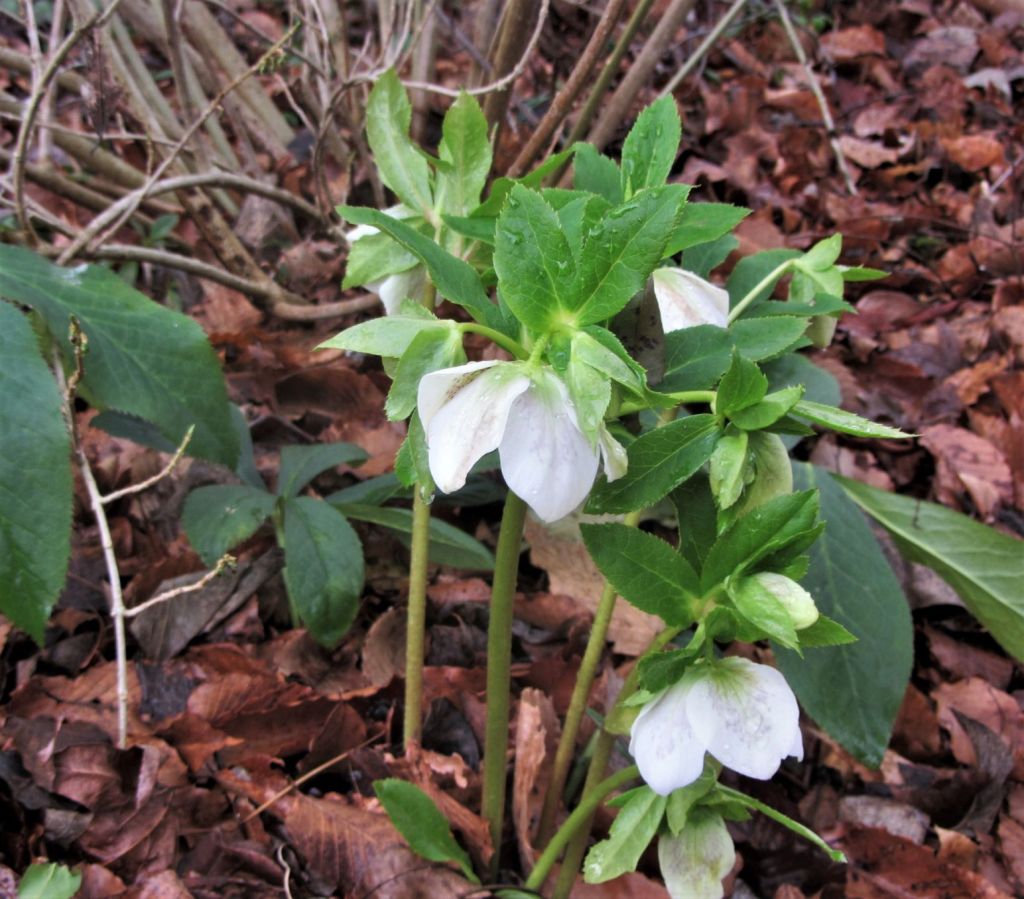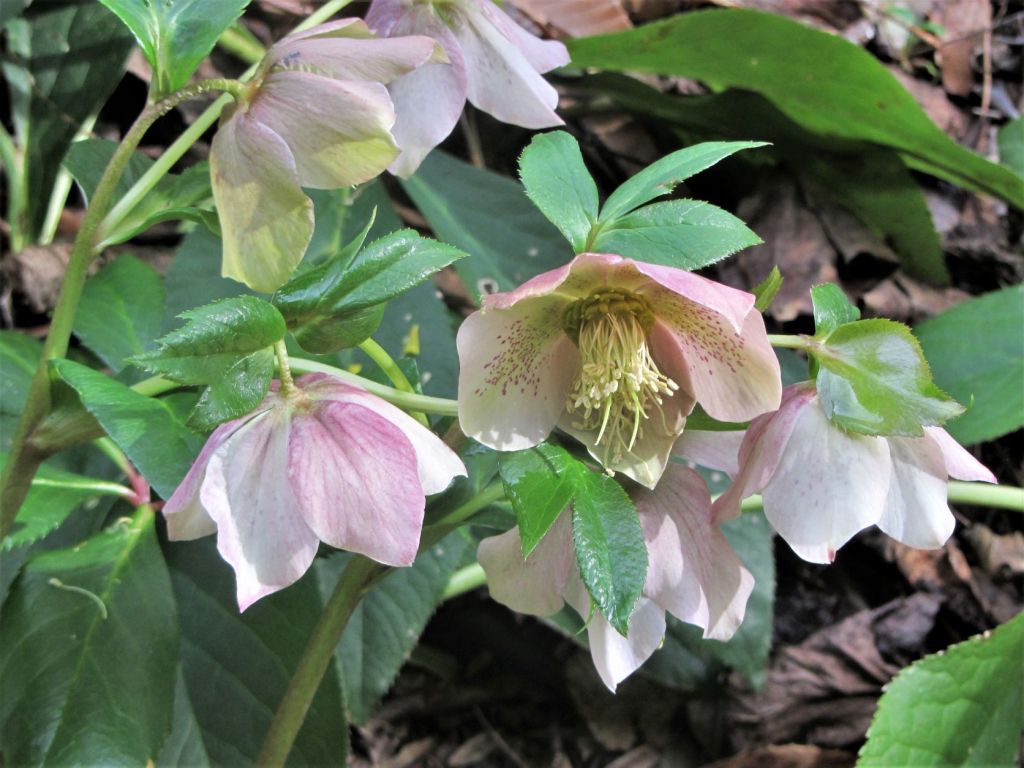
We enjoyed a bright, balmy day last Wednesday and a breath of what’s to come. I wandered around looking for signs of spring, camera in hand, and found a beautiful little bee hovering around the Lenten roses. The first of our daffies bloomed midweek, spots of golden yellow against winter browns and greys. The life of our garden is poised for that step into spring, while still clinging to a bit of shelter, knowing that more cold weather will follow.
I’ve been clearing things up to make way for new growth. Our consistent cold and damp weather through February slowed me down a bit this year, and again today I’m sitting indoors writing rather than pruning in this morning’s fog. Better days ahead, right?
Many of our garden plants are self-sufficient and need nothing from us once planted. But there are still things to do as we prepare for the change of seasons from winter to spring, and there is pleasure along the way as we see bits of flower buds swelling along woody stems or poking through the mud.

I am still cutting back perennial stems left standing last fall. I try to work through the various areas in blocks, when the ground is firm enough between rain showers, cutting back and pulling weeds. Japanese honeysuckle has crept through several of these areas, growing up through the interior of shrubs searching for the light. In other areas, Japanese Akebia quinata, or chocolate vine, has colonized both the shrubs and the ground, sending long runners out at ground level, weaving over and under one another, looking for any opportunity to send up new stems and leaves.
Getting the vines under control before they spurt with spring growth takes time, attention, and dexterity. Pulling the vines up from the ground and down from the canopy and then moving them to the refuse pile proves dicey around the feet and ankles. They fight back in whatever way they can. The wild grapes need similar discipline to limit their spread, and to improve their new growth.
Pruning is mostly about discipline; about seeing the structure of a plant and understanding what to remove to improve its growth and health. It takes self-discipline to get out there in February, before new growth begins, to accomplish the work, too.

Any diseased or damaged stems should be removed first. A cut back to the main stem removes that branch entirely. A cut back to a bud allows the remaining buds to break open and grow, so choose the first bud beyond the cut carefully, as it will grow in the direction it is facing, into a new stem. The top bud below the cut should be facing outwards, away from the center of the plant.
Any crossing branches must be fixed by cutting back one or both of them. Any branch growing well beyond the outline of the shrub should be pruned, and some gardeners also thin out any congested stems to allow for airflow through the plant. Space between branches improves the appearance of most woody plants.
Some gardeners derive a great deal of pleasure from pruning. It is hard for me to remove perfectly healthy buds and branches, even understanding why it is necessary. That is why I often stick healthy cuttings into a pot of soil or even directly into the ground, in hopes they will root, and I can use the new plants or give them away.

Hardwood cuttings, taken between November and February, will usually root by May. They shouldn’t be too long. Work with cuttings no more than 4 or 5 buds long for best result, with the two lower buds under the soil. If the plant still has some leaves, remove all of the lower ones, and all but a few of those remaining to reduce stress on the cutting. I keep a bottle of rooting hormone handy to dip the stems before sticking them, increasing the chances of success.
New leaves will emerge once the stem roots and the weather warms. Leave the stems alone in moist soil for the first few weeks, checking for rooting after about a month by gently pulling the stem upwards to check for resistance. I have still been sticking cuttings this week, as I prune, in expectation of generating a few new plants.

This chilly, damp weather is the perfect environment for new growth. Some species may appreciate bottom heat for their cuttings, but most hardy woodies will root outdoors, even if it takes a bit more time. Our moss is loving the frequent rain and fog. Each warmish day brings more bulbs into view, with Scilla siberica, Crocus, and daffies already in bloom.
This is the perfect time to spread fresh compost or other soil additives. I’ve been feeding the Irises with dried worm castings and kelp meal. Now is also the moment to add mulch, while most perennials remain dormant.
A few yellow flowers opened on the Forsythia beside the gate, yesterday. Japanese quince leaves appeared this week, and ruby red flower buds look ready to burst open on the next bright day.
Cleaning up the old creates space to appreciate the new in life, and in the garden. Constant renewal keeps us fresh, contented, and sharing in the wonder of life.

With appreciation to The Propagator, who hosts Six on Saturday each week.
Great guns! We’re still buried under 2 feet of snow! I hope to be doing what you’ve been doing in another month. Usually, we are nearly snow-free by now – this year is a bit different 🙂
Thanks for your post! -Kate
LikeLiked by 1 person
May the breath of spring find you soon. This cool weather is delaying everything here a bit. We’re normally much further along by the end of February, but after last summer, I’m enjoying the cool while we can! ❤ ❤ ❤
LikeLiked by 1 person
Lovely colours for your Hellebores.
LikeLiked by 1 person
Yes, we are enjoying them so much this year.
LikeLike
Oh, I miss the daffodil and narcissus. Their bloom lasted for quite a while this year, but it is brief nonetheless. There were a few feral daffodil outside of the garden here that were blooming only recently! Because they are outside the garden, I brought them in as cut flowers.
LikeLiked by 1 person
That is a lovely way to appreciate them. When do your daffies begin blooming? Our ‘early spring ‘ varieties are still out, and the late ones haven’t yet broken ground.
LikeLike